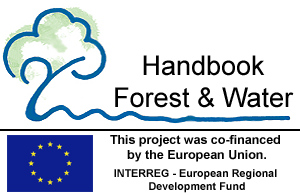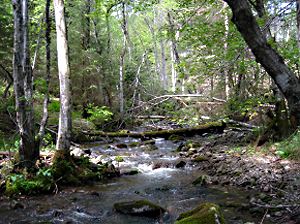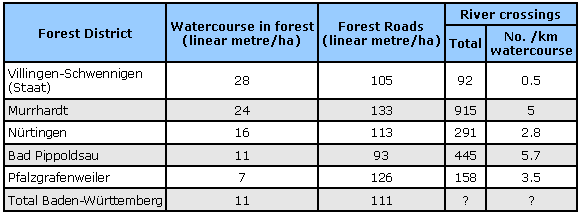

Fig. 1: Krunkel Stream, Waldshut, southeastern Feldberg.
This article, drawing on forest management measures, deals with the core business of a forest enterprise, timber production and use. It tries to respond to the relationship between watercourses and relevant aspects of forestry, including forest planning. When evaluating measures, a distinction is made between effect and impact.
One speaks of effects when measures carried out by a forest enterprise in a watercourse or its environs:
- a. Are neither extensively nor lastingly damaging to the water course; or
- b. Are judged positively, as with the development of dead wood in a watercourse.
The boundary between effect and impacts is fluid, depending on the perspective of the observer. For example, harvesting trees in stream environs because of shading changes amongst other changes, could be considered as interference. However here, the careful harvesting of trees in accordance with today’s usual single tree or small area technique, would be understood as a measure in accordance with the proper care and management of forests (refer Land and Forest Law section 12, 14 and 22), that although exhibit effects on a watercourse, they are neither extensive nor lasting and therefore aren’t objectionable from an aquatic ecological perspective. In contrast, the consequences of a large clear-cut that concerns hundreds of meters of stream length would fall under impact.
Consideration is given to the small and middle-sized watercourses which are especially impacted by the forest. Small and middle-sized watercourses are waterways 5 - 10metres wide with an average yearly discharge of less than 5 m3/sec and a catchment area up to 150 km2 in size (Schwabe 1987, Böttger & Pöpperl 1990). The definition of a stream by Humborg (1995) in his description of streams as small and middle-sized watercourses, in contrast to rivers is very illuminating: A river begins there where the width of the waterway is so big that the canopy of a grove of riparian trees can no longer cover it. According to Otto (1991) the riparian groves of small watercourses play a formative role in watercourse morphology, in contrast to rivers where they play only a secondary role.
A picture of the comprehensiveness of the entire watercourse network (steams and rivers) in Baden-Württemberg and its length within forests is given in Table 1. The actual length of all stretches of water is higher than that calculated by the Forest Water Division (AWGN) of the Environment Ministry of Baden-Württemberg (LfU). In the AWGN many water stretches flow back on themselves or flow in meandering paths rather than in a straight line, which leads to a shorter calculated length. The total length of all water courses in Baden-Württemberg could actually be about 50,000km, with about 40,000km of small and middle-sized streams (LfU 1998).
| Tab. 1: The water network in Baden-Württemberg: Total length and length in forest. Data source: ATKIS-Dataset, Stand 03/2002 (Forest area) and LfU-Dataset "River10k", Stand 12/2002 (Watercourse). For watercourses inside forests, the surface area of the water stretch that is covered in forest was captured. |
| Watercourse | Length (km) | Proportion (%) |
| Baden-Württemberg total | 43.25 | 100 |
| Within the forest of Baden- Württemberg | 15.5 | 35.9 |
Watercourse relevant forestry measures
A baseline is needed to judge the effectiveness of forestry measures on a watercourse. This must be appropriate to evaluating measures with respect to their influence on the condition of a watercourse. As a basis for evaluating forest management measures, or the condition of the watercourse in the forest, the watercourse ecology, especially the aquatic fauna, is chosen. This article follows the evaluation of measures according to the technical approach of the EU Water Directive Framework. This allows for a condition assessment or monitoring of our watercourses to check compliance with the EU-WRRL guidelines and above all on the basis of aquatic fauna and flora characteristics.
Different effects on watercourses stem from the measures undertaken in managed forests which are described under the sections of Silviculture Measures, Forestry Road Building and Timber Harvesting and Timber Storage and are evaluated on the basis of their effects on aquatic fauna. The basis for the evaluation comes from technical literature and actual research.
Silviculture Measures
According to Scherzinger (1996), the restructuring of the forest for timber purposes has caused by far the largest interference in the forest ecosystem, the most important of which among others, are the following interrelationships with watercourses in forests:
- Controlling the tree species composition to favour the so called "forestry tree species" relating to a reduction in natural tree species diversity
- Lowering the tree stand age with sustained impacts on the proportion of dead wood
- Fragmentation of the forest through site development and clear cuts.
Controlling the tree species composition: Changes in the predominantly leaf-input controlled, allochthonous food supply in water courses by stocking the riparian margin with non-local, conifery can be traced back to the unilateral encouragement of forestry tree species, above all Norway Spruce (Picea abies). Effects of riparian coniferous stands on the benthic community of watercourses have been reported e.g. von Hering et al. (1993) and Friberg et al. (2002).
Hering et al. (1993) could show that the input of needle litter has an impact on the benthic fauna of middle mountain streams with respect to feeding types. The frequency of so called macerators or shredders, e.g. Asellus or Gammarus was considerably lower in the spruce stocked section of the researched watercourse, with less than a fifth of that of the broadleaved forest lined section. The decrease is explained through a food shortage, as needle litter is mainly only poorly decomposed by micro-organisms and is then difficult for macerators to grasp. It was shown that needle litter was avoided as a food source by a stream crab flea species. Results of recent research by Friberg et al. (2002) from Denmark are very similar. The biomass of shredder feeding species was significantly lower, by about 4/5, in streams in conifer plantations compared to streams in beech forests. This was due to changes in water temperature, chemical balance and food supply. The authors especially highlighted the negative impacts on secondary production. Macerators are important precursors for the decomposition of large plants into detritus (fine particulate organic matter), especially of leaves from terrestrial environs that end up in the water course. They make large particulate material available to sediment and filter feeding species (Schwoerbel 1999). If the proportion of macerators falls markedly there is a significant influence on the benthic food chain
Grazers (algae feeders), sediment feeders and filter feeders (see above) as well as predators also appear in much lower densities in coniferous forest sections, in comparison to broadleaf forest sections (1/4 to a 1/3 the number of individuals). This is due to food shortages caused by light reduction, loss of leaf fall and hence detritus and prey in conifer or spruce stands. The results of the research by the Forest Research Institute of Baden-Württemberg (FVA) could however also show that stretches of water with a conifer rich riparian forest, but with a few prominent broadleaf trees (scattered or in groups), supported a benthic composition which quite closely approached a pure broadleaf forest section.
The dispersion of animals in the air above watercourses, noteworthy are the upstream flying insects, is influenced by the composition and structure of riparian forests. Hering et al. (1999) could prove that for various insect species who undertake upstream flights, cohorts of densely growing 25 – 40 year old pure spruce stands acted as dispersion barriers. Various causes of the barrier effect are hypothesized: dense conifer stands form visual barriers in comparison to broadleaf forest sections where the low air pressure acts as a climatic barrier, dense conifer growth possibly hinders orientation via vespertine valley winds which serve as directional guides for flying insects and so on. Such hindering effects particularly affect species with low dispersal ranges and a close relationship with the watercourse like many mayflies and several species of caddis fly. For very mobile species, like dragonflies, these barrier effects play a lesser role.
Lowering the tree stand agethrough use long before the natural maturation age of forest timber, leads not only in terrestrial, but also in aquatic habitats, to a shortage of deadwood. Deadwood plays an important role in watercourse structure, the development of currents and hydraulics, hydrology, habitats and food sources (GFG & WBW 2001). The value of deadwood to watercourse structure will be shown here, specifically pool development through deadwood. A changing river bottom sequence of riffles and pools is typical of many mountain and hill streams, but also of larger rivers. Very deep pools arise from deadwood lying across the current. These serve as refuges for fish, especially during low water levels in summer (Carlson et al. 1990, Gurnell et al. 1995). They also offer protection from predators (e.g. grey herons) or during floods provide areas of lower current speed which fish prefer to stay in (Maser & Sedell 1994). There is other research which shows that the occurrence of pools appears to be a factor which limits the size of fish populations or that different development stages and species of fish favour various types of pool size and depth (Fausch & Northcote 1991, Bilby & Ward 1989).
Furthermore, in watercourses tightly bound to the occurrence of deadwood, the development of dams as calm water areas and the promotion of lateral development of the watercourse through bank erosion are, from an aquatic ecological point of view, important morphological structures or effects. Calm water areas are formed by deadwood lying against the current over the entire water course width (Bilby & Ward 1989). Side erosion is intensified by deadwood which diverts the current against the bank which increases the width variance (alterations between narrowing and widening) (Gurnell et al. 1995, Robison & Beschta 1990). In this way deadwood can also contribute to the restoration of watercourses (Hering & Reich 1997).
By promoting the development of deadwood in riparian environments, a forest enterprise can contribute to increasing the amount of deadwood. Under the Baden-Württemberg Water Law (clause 47 disturbances to the watercourse are to be rectified), deadwood, because of its high ecological values, should only be removed in exceptional circumstances.
Fragmentation of the forest through site development and clear cuts: The impact of site development will be described in the following section. Fragmentation of the forest through logging by clear-cuts up to 1ha in size would be categorized, with respect to aquatic ecological aspects, as unobjectionable (clear cuts > 1.0 ha in size are not allowed without the permission of the forest authority – section 15 of the Baden-Württemberg Land Forest Law)
Forestry Road Building
Opening up of the forest via forestry roads inevitably leads to disturbances in longitudinal passability through the construction of river crossings. The travel routes of fish and small aquatic creatures are disturbed or even prevented by these water crossings. During forestry road building, small streams (bottom width 2 – 3 m) are usually crossed with a concrete culvert. Its passability depends on the properties of the pipe, the current and light conditions. In addition, substantial scour occurs beneath the culvert, causing a greater or smaller washout depth. Deep washouts at the pipe discharge point inhibit the upstream entry of small animals and fish. Macro-invertebrates, which live on or in the river bottom, can not travel against the flow direction through pipes with steep inclines, high water speeds and smooth surfaces. Very narrow and long (> 25 - 30 m) and therefore dark pipes, are only sporadically passed through by fish and very long constructions (> 50 m) probably not at all (Liebsch et al. 1995).
Data analysis from the forest streams studied by the FVA was surprising with its high number of water crossings, in absolute as well as relative terms, corresponding to a 1km length of water (Table 2). In the best case (Villingen-Schwenningen Forest District), there is a water crossing – usually with a culvert - every 2 km, in the worst case (Bad Rippoldsau Forest District) one every 175 metres and on average, over all five considered forest districts, one every 300 m.
To better evaluate the impact of the numerous water crossings, especially on the fish fauna, a condition analysis of 53 forest and machine road river crossings was carried out in the Nürtingen Forest District based on the survey data and according to the methods of the FVA. The average length of the piped areas was between 3m and 33m, the mean was 8.5m. Old pipes have a diameter of 30-40cm, new ones between 50 and 100cm. The largest measured diameter was 300cm.
The entrance possibility is especially critical for fish passage through culverts. For less climbing capable species like bullheads (Cottus gobio), a pipe rim height of 20cm and a culvert counts as a passage barrier. Beneath 19 of the 53 culverts (36%) a 10 to 80cm washout had formed. A washout >= 20 cm occurred at 11 culverts (21 %), i.e. almost every fifth examined water crossing posed a dispersion hindrance to bullheads. Fish passage for these types of fish can only be reinstated through a corresponding retrofitting. Appropriate options have already been referred to earlier (Bönecke 2002b) or described in articles from Bönecke, Gilly and Rinderspacher.

Tab. 2: Forest District, Watercourse density, Road density and Water crossings in the Forest.
Datasources: ATKIS-Dataset, Stand 03/2002 (Forest area) and LfU-Dataset "Fluss10k",
Stand 02/2002 (Watercourses).
Timber Harvesting and Timber Storage (Wet Storage)
Timber Harvesting: Damage to the bank structure and the bank and riparian vegetation can occur during timber harvesting due to felling and skidding. An increase in fine material input to forest streams is a possible consequence of soil damage caused by heavy forest machinery. In both cases disadvantageous impacts are imaginable depending on the sensitivity of the affected location or the presence of rare and endangered plant and animal species. A species especially sensitive to sand movement and mud turbulence, is for example Baden-Württemberg’s extremely threatened river mussel (Unio crassus). It occurs only sporadically in forest water courses, especially in the middle reaches of fast flowing streams of low mountain ranges (LfU 1995, Bayerisches Landesamt für Umweltschutz 1995).
Corresponding with the use of harvesting machinery, fine material input from forest stands has gained in importance since the middle of the 1980s. With regard to water courses in forests two aspects have to be considered. One can be considered in its entirety under the forestry road building section describing circumstances for the construction of water crossings for machine use. The other relates to the technical trafficking capacity of skid roads using the recommended construction means such as brush matting or anchoring points made by gravel placement. These should never be used to make a small watercourse crossable when developing a skid road.
Wet Storage: The analysis of irrigation water samples by the Hessian Forest Research Institute (Hammes 1989, Best et al. 1994) which measured pH values, electric conductivity and certain inorganic dissolved materials, indicated no critical changes in water quality. During the establishment phase of water storage enrichment effects, NH4-concentrations, chemical oxygen demand and biological oxygen demand were clearly apparent but sunk markedly after the first year of timber conservation. It appears that organic compounds released through water storage are predominantly biodegradable and don’t have any toxic effects. Water samples that were taken about 100m below the storage area irrigation water outlet no longer had any detectable influence on water quality. Following an extensive literature review, Rupp (2002) concluded that: There is no evidence of a connection between wet storages and acute damage to fish populations or even fish death. The concentrated input of leached material from timber piles over 2,000m3 is according to Rupp however, a material burden that can have negative impacts on aquatic communities.
No lasting negative impacts on watercourses are expected through the wet storage of round timber, if the appropriate guidelines for construction and use of wet storage areas are followed (e.g. FD Freiburg 2000).
